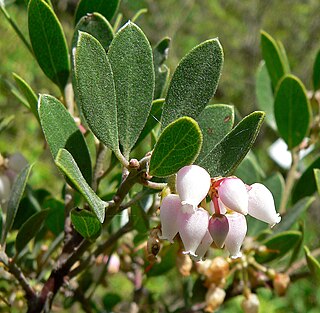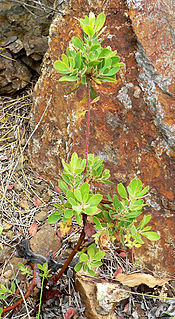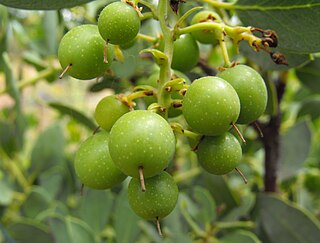
Manzanita is a common name for many species of the genus Arctostaphylos. They are evergreen shrubs or small trees present in the chaparral biome of western North America, where they occur from Southern British Columbia and Washington to Oregon, California, Utah, Arizona, New Mexico, and Texas in the United States, and throughout Mexico. Manzanitas can live in places with poor soil and little water. They are characterized by smooth orange or red bark and stiff, twisting branches. There are 105 species and subspecies of manzanita, 95 of which are found in the Mediterranean climate and colder mountainous regions of California, ranging from ground-hugging coastal and mountain species to small trees up to 20 feet (6m) tall. Manzanitas bloom in the winter to early spring and carry berries in spring and summer. The berries and flowers of most species are edible.

Arctostaphylos is a genus of plants comprising the manzanitas and bearberries. They are shrubs or small trees.

Arctostaphylos auriculata is an endangered species of Arctostaphylos endemic to California, and limited in geography to the area surrounding Mount Diablo, in Contra Costa County.

One of many species of manzanita, Arctostaphylos manzanita has the common names common manzanita and whiteleaf manzanita.

Arctostaphylos viscida, with the common names whiteleaf manzanita and sticky manzanita, is a species of manzanita.

Arctostaphylos edmundsii, with the common name Little Sur manzanita, is a species of manzanita. This shrub is endemic to California where it grows on the coastal bluffs of Monterey County.

Arctostaphylos hookeri is a species of manzanita known by the common name Hooker's manzanita.

Arctostaphylos parryana, with the common name Parry manzanita, is a species of manzanita.

Arctostaphylos glandulosa, with the common name Eastwood's manzanita, is a species of manzanita.

Arctostaphylos pallida, commonly known as pallid manzanita, Oakland Hills manzanita, and Alameda manzanita, is an upright manzanita shrub from the Ericaceae, or heath family. It is endemic to the eastern San Francisco Bay Area of Northern California.

Arctostaphylos bakeri is a species of manzanita known by the common name Baker's manzanita. It is endemic to Sonoma County, California, where it grows in the chaparral and woodlands of the North Coast Ranges. It is sometimes a member of the serpentine soils flora.

Arctostaphylos mewukka is a species of manzanita known by the common name Indian manzanita.

Arctostaphylos myrtifolia is a rare species of manzanita known by the common name Ione manzanita. It is endemic to the Sierra Nevada foothills of California. It grows in the chaparral and woodland plant community on a distinctive acidic soil series in western Amador and Calaveras Counties. There are only about 17 occurrences, but the plant is abundant in some areas of its limited range. This is a federally listed threatened species.

Arctostaphylos nevadensis, with the common name pinemat manzanita, is a species of manzanita.

Arctostaphylos obispoensis is a species of manzanita, known by the common names bishop manzanita and serpentine manzanita, endemic to California.
Arctostaphylos pilosula is a species of manzanita, known by the common names La Panza manzanita and Santa Margarita manzanita, that is endemic to California.

Arctostaphylos refugioensis is a species of manzanita, known by the common name Refugio manzanita. It is endemic to Santa Barbara County, California, where it can be found along the immediate coastline, including the vicinity of Refugio State Beach, and into the Santa Ynez Mountains of the northwestern Transverse Ranges.

Arctostaphylos rudis, with the common names Shagbark manzanita and Sand mesa manzanita, is a species of manzanita.

Arctostaphylos virgata is a species of manzanita known by the common names Bolinas manzanita and Marin manzanita.

Arctostaphylos rainbowensis is a species of manzanita known by the common name Rainbow manzanita. It is endemic to California, where it is known only from northern San Diego and southern Riverside Counties in the Peninsular Ranges.


















